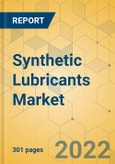Speak directly to the analyst to clarify any post sales queries you may have.
The global synthetic lubricants market is expected to witness stagnant growth during the forecast period. The consumption of synthetic lubricants is majorly driven by automotive and transport sector.
The synthetic lubricants market is expected to grow at a CAGR of 3.48% during 2021-2027
MARKET OPPORTUNITIES AND TRENDS
- Increasing Demand for Reduction in Emission
- Demand For Higher Fuel Economy Vehicle
- Increasing Demand for High-Performance Lubricants
GLOBAL SYNTHETIC LUBRICANTS MARKET SEGMENTATION
Automotive and transportation are the largest segment by end-use. Automotive and transportation synthetic lubricants accounted for 32.20% market share in 2021. The automotive and transportation segment is expected to register a CAGR of 3.76% during the forecast period. Advantages driving the demand for synthetic lubricants in this segment are wear and tear prevention, reduced friction, proper heat dissipation, oxidation and corrosion prevention, component stress relieving, and maintaining proper engine functionality.
Segmentation by Application
- Engine Oil
- Transmission Fluids & Hydraulic Fluids
- Metalworking Fluids
- Greases
- Others
Segmentation by End-user
- Power Generation
- Automotive & Transportation
- Heavy Equipment
- Food & Beverage
- Other
Segmentation by Type
- Polyalphaolefin
- Esters
- Polyalkylene Glycol
VENDOR ANALYSIS
Shell (US), ExxonMobil (US), British Petroleum (UK), Chevron (US), and Sinopec (China) are some of the key players in the synthetic lubricants market. The market is largely commoditized, with price serving as a significant differentiator. Manufacturers are constantly involved in developing new and sustainable products as per customer requirements and safeguard environment as well.
Some Developments:
The FUCHS Group, had signed an agreement to acquire the lubricants business of Gleitmo Technik AB, and is expected to integrate it into its subsidiary FUCHS LUBRICANTS SWEDEN AB. Sinopec entered into the South African market by acquiring a majority stake in Chevron’s lubricant facility. Shell Indonesia announced investment to double the production capacity of its lubricants oil blending plant (LOBP) located in Jakarta, Indonesia. When completed the plant would produce up to 300 million litres of finished lubricants, annually.
Key Vendors
- Royal Dutch Shell
- ExxonMobil
- British Petroleum
- Chevron
- Sinopec
Other Prominent Vendors
- Total Energies
- Fuchs
- Idemitsu Kosan
- Lukoil
- Petronas
- Indian Oil
- Dow
- Morris Lubricants
- Sasol
- Valvoline
- Penrite oil
- Bharat Petroleum
- Liqui Moly
- Peak Lubricants
- Amalie Oil
- Eni
- Addinol
- Engen Petroleum
- Croda International
- Petro-Canada Lubricants
GEOGRAPHICAL ANALYSIS
APAC is the leading market for synthetic lubricants. The region accounted for 45% market share in 2021. The growth in the region is associated with the increasing demand for automotive and high-performance industrial machinery and equipment. APAC region consists of emerging as well as developed economies such as Japan, China, India, South Korea, and Australia. These countries have considerable demand for automotive, agricultural, and construction vehicles. APAC region is also a hub for the growth of new industrial developments such as advanced manufacturing, smart cities, smart construction, and so on.
Segmentation by Geography
- North America
- US
- Canada
- Latin America
- Brazil
- Mexico
- Middle East & Africa
- Saudi Arabia
- UAE
- APAC
- China
- India
- Japan
- South Korea
- Indonesia
- Europe
- Germany
- UK
- France
- Italy
- Spain
THE REPORT INCLUDES:
1. The analysis of the global Synthetic Lubricants market size and growth rate for the forecast period 2022-2027.
2. It offers comprehensive insights into current industry trends, trend forecast, and growth drivers about the global Synthetic Lubricants market.
3. The report provides the latest analysis of market share, growth drivers, challenges, and investment opportunities.
4. It offers a complete overview of market segments and the regional outlook of the Synthetic Lubricants market.
5. The report offers a detailed overview of the vendor landscape, competitive analysis, and critical market strategies to gain competitive advantage.
Table of Contents
Companies Mentioned
- Royal Dutch Shell
- ExxonMobil
- British Petroleum
- Chevron
- Sinopec
- Total Energies
- Fuchs
- Idemitsu Kosan
- Lukoil
- Petronas
- Indian Oil
- Dow
- Morris Lubricants
- Sasol
- Valvoline
- Penrite oil
- Bharat Petroleum
- Liqui Mol
Methodology
Our research comprises a mix of primary and secondary research. The secondary research sources that are typically referred to include, but are not limited to, company websites, annual reports, financial reports, company pipeline charts, broker reports, investor presentations and SEC filings, journals and conferences, internal proprietary databases, news articles, press releases, and webcasts specific to the companies operating in any given market.
Primary research involves email interactions with the industry participants across major geographies. The participants who typically take part in such a process include, but are not limited to, CEOs, VPs, business development managers, market intelligence managers, and national sales managers. We primarily rely on internal research work and internal databases that we have populated over the years. We cross-verify our secondary research findings with the primary respondents participating in the study.

LOADING...
Table Information
| Report Attribute | Details |
|---|---|
| No. of Pages | 301 |
| Published | March 2022 |
| Forecast Period | 2022 - 2027 |
| Estimated Market Value ( USD | $ 4199.95 Million |
| Forecasted Market Value ( USD | $ 5155.95 Million |
| Compound Annual Growth Rate | 3.4% |
| Regions Covered | Global |
| No. of Companies Mentioned | 18 |









